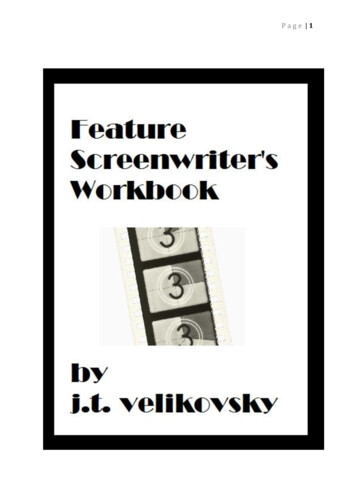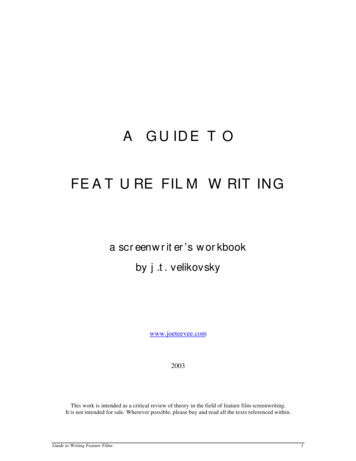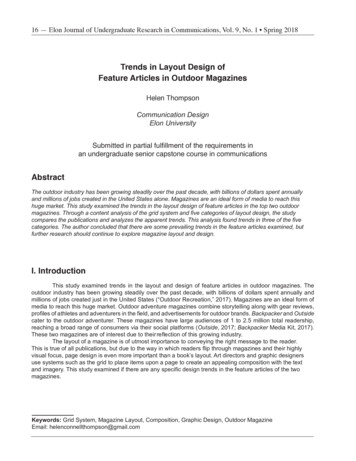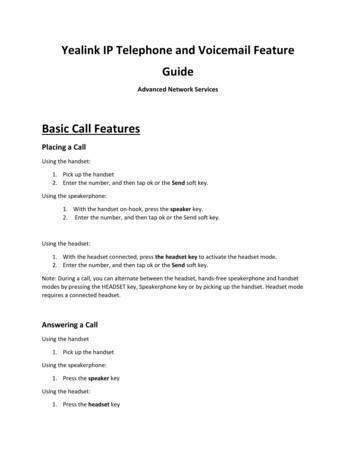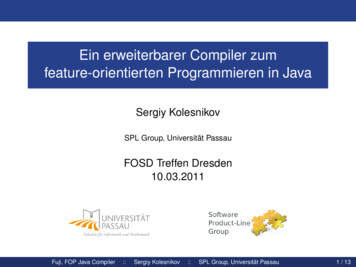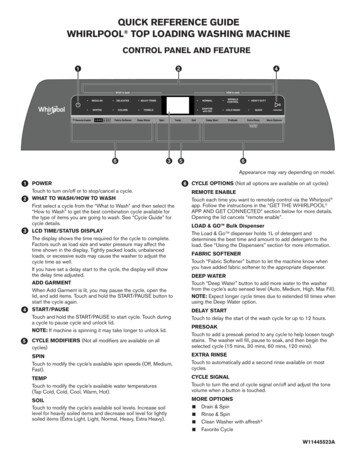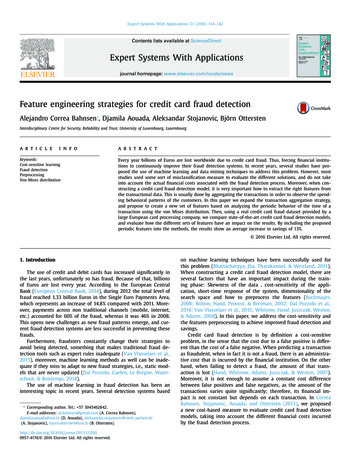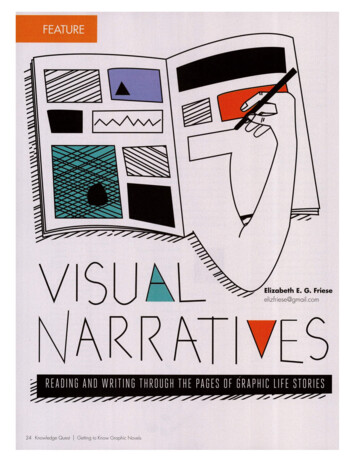
Transcription
FEATUREE l i z a b e t h E. G . F r i e s eelizfriese@gmail.com1 2 Knowledge Quest Getting to Know Graphic Novels
I A D M I T IT; I U S E D TO T H I N K T H I S W A Y M Y S E L F .I T H O U G H T OF G R A P H I C N O V E L S AS A G A T E W A YTO " M O R E L E G I T I M A T E " R E A D I N G — U N T I L , OEC O U R S E , I SAT D O W N TO A C T U A L L Y R E A D O N E .A S n i p p e t f r o m My C l a s s r o o mtheir choices with each otherMy s t u d e n t s a r e n ' t t h e o n l yIt h a p p e n s e v e r y s e m e s t e r , w i t h o u twithin their small groups, and theno n e s w h o s e e m to see p i c t u r e sfail. A t least o n e of my s t u d e n t s ,s h a r e t h e i r d e c i s i o n s w i t h t h e class.as e i t h e r a r e a d e r ' s c r u t c h o r aargue, "We (educators) wantAs you might imagine, this exercisev a r i a t i o n s of t h e s e s e n t i m e n t s allwho are pre-service teachers, willsign of a s i m p l e r text. I h e a rto get t h e s t u d e n t s away f r o mis a n i m p o s s i b l e t a s k f o r s e v e r a lthe time, perhaps especially inbooks with pictures, and upr e a s o n s . T h e m o s t p r e s s i n g of theset e r m s of p o p u l a rinto books with only words."r e a s o n s is t h a t w e d o n ' t k n o w w h oabout graphic novels. Mostt h e r e a d e r s of these b o o k s will be.often, I find these perceptionsI respond,We don't k n o w t h e i r l a n g u a g e skills,h i d d e n in article titles a n d o t h e r"Why?"conversationstheir background knowledge, orconversations that target graphict h e i r r e a d i n g p r e f e r e n c e s , all ofn o v e l s as b o o k s f o r " r e l u c t a n tfewer pictures in a book, thewhich factor in to the challengesr e a d e r s . " T h i s seems to implyh a r d e r t h e b o o k is t o r e a d . "t h a t m i g h t exist b e t w e e n a specificthat graphic texts are a n i n f e r i o rT h e student replies,"Thebook and a particular reader.type of r e a d i n g , or s o m e t h i n g toT h i s s h o r t e x c h a n g e is r e p e a t e dS t i l l , t h e e x e r c i s e is a n i n t e r e s t i n gget y o u n g r e a d e r s i n t e r e s t e d i nin each children's literatureway to b r i n g to light s o m e ofbooks, with the hope that theyc o u r s e I teach. I n the m i d d l e ofthe (previously)will eventually move o n to m o r eseveral m o n t h s spent i n q u i r i n gassumptions my students carryinto literature, media,a b o u t d i f f e r e n t k i n d s of b o o k s . Aandunchallengedchildren's reading, I place ap r e v a i l i n g a s s u m p t i o n in everym i x e d pile of b o o k s o n each tableg r o u p of these p r e - s e r v i c e t e a c h e r sacceptable (read: word-only) texts.My O w n J o u r n e y i n t o R e a d i n gGraphic Literatureof f o u r s t u d e n t s . E a c h g r o u p ' sis t h a t b o o k s w i t h o u t p i c t u r e s a r ej o b is t o o r g a n i z e t h e j u m b l e dthe m o r e c h a l l e n g i n g texts studentsarray of p i c t u r e books, g r a p h i cs h o u l d strive to be r e a d i n g . At h i s way m y s e l f . I t h o u g h t ofnarratives, novels without images,c o r o l l a r y a s s u m p t i o n is t h a t p i c t u r e sg r a p h i c n o v e l s as a g a t e w a yI a d m i t it; I u s e d to t h i n ki n f o r m a t i o n a l texts, a n d o t h e rare a n aspect of b o o k s that readersto " m o r e l e g i t i m a t e "b o o k s i n o r d e r " f r o m easiest ton e e d to be w e a n e d f r o m in t h e i ru n t i l , of c o u r s e , I sat d o w nhardest." Students must debatequest to achieve m a t u r e literacy.to actually readreading—one.Volume 41, No. 3 January/February 201 325
I N S T E A D DF A N I N F E R I O R T Y P E OF R E A D I N G , IREALIZED THAT GRAPHIC NARRATIVES REPRESENTA M O R E S O P H I S T I C A T E D , M U L T I M O D A L F O R M OFREADING THAN A L P H A B E T - O N L Y TEXTS. ONCE IF I G U R E D T H I S OUT, I W A S H O O K E D .I r e m e m b e r this experiencewas g o i n g o n i n t h e b o o k becauseclearly. In p a r t because g r a p h i cI was r e a d i n g o n l y t h e w o r d s . Im u l t i m o d a l f o r m of r e a d i n gt h a n a l p h a b e t - o n l y texts. O n c en o v e l s w e r e b e c o m i n g so p o p u l a rwasn't r e a d i n g the pictures. AsI f i g u r e d t h i s out, I was h o o k e d .in school libraries, I decided toI reached for more and morestart reading t h e m along with ag r a p h i c texts, I realized that,Y o u may have n o t i c e d that I o f t e np r o f e s s o r at m y u n i v e r s i t y . I b e g a nlike my p r e - s e r v i c e students, Iu s e t h e t e r m graphic narrativewith what some mightprized the word over the pictureto these texts ( C h u t e a n d D e K o v e nas b o t h a r e a d e r a n d a t e a c h e r .2 0 0 6 ) . As I read these books withW i t h a g r a p h i c narrative, to readwhat to call t h e m . A f t e r r e a d i n g aa "classic" g r a p h i cconsidernarrative,Persepolis: The Story of a Childhood.Iflew t h r o u g h the comic-style pages,to referm y c o l l e a g u e , we p u z z l e d o v e rzooming along with seeminglyboth the words and the pictures, In u m b e r of g r a p h i c texts, I realizedlittle to stop m e . I f o u n d myselfh a d to consciously slow d o w n , overthat my favorites weren't novels, perw o n d e r i n g what t h e big deal was,a n d over again. I h a d to r e l e a r nse, b u t g r a p h i c m e m o i r s . I n s t e a da n d why p e o p l e liked these b o o k sto read, a p p r o a c h i n g each pageof s u p e r h e r o e s a n d i m a g i n e dso m u c h . I d i d n ' t e v e n u n d e r s t a n ddifferently and developing ancharacters, I f o u n d myself absorbedh a l f of w h a t was g o i n g o n .a p p r e c i a t i o n f o r t h e way w o r d s a n din books like A r t Spiegleman'spictures worked together. InsteadMaus: A Survivor'sT h e n it h i t m e : My w o n d e r i n g wasof a n i n f e r i o r type of r e a d i n g , IT h o m p s o n ' s Blankets.m o r e true t h a n I knew. I honestlyrealized that graphic narrativesshelves of m a n g a series a n d s e r i a l sd i d n ' t u n d e r s t a n d half of whatrepresent a more sophisticated,to t h e "single b o o k "1 2 Knowledge Quest Getting to Know Graphic NovelsTale a n d C r a i gI p a s s e d by t h egraphic
Graphic Life Storiesand Writingstudents approached these graphict e x t s as s e r i o u s a c a d e m i c t o o l s w h e nt h e y w e r e p r e s e n t e d as s u c h i n t h eT h e b e n e f i t s of g r a p h i c textsclassroom (2012). With this in m i n d ,f o r r e a d i n g are relatively wellI'll share several d i f f e r e n t ideas forestablished. A l o n g the manyusing graphic novels to e n h a n c ee x a m p l e s of r e s e a r c h i n t o r e a d i n gcomics, Stephen D. K r a s h e npersonal-narrativecompositions.(2004)heralded comics and other "light"r e a d i n g as i m p o r t a n t e l e m e n t s i nd e v e l o p i n g l i t e r a c y . L o o k i n g ato l d e r r e a d e r s of comics, StergiosD r a w i n g as a P a t h w a yinto WritingFor many writers, drawing can beBotzakis ( 2 0 0 9 ) described the rich,a n i m p o r t a n t p o i n t of e n t r y tocritical-literacy practices that thesec o m p o s i n g life stories. We k n o wtexts i n s p i r e . G i v e n the substantivet h i s is t r u e f o r m a n y o f o u r y o u n g e rb o d y of w o r k s u p p o r t i n g g r a p h i cauthors (Horn and Giacobbe 2007),texts in r e a d i n g d e v e l o p m e n t , I'db u t j u s t as m y c o l l e g e s t u d e n t s o f t e nlike to shift my focus a bit a n doverlook the complexities of b o o k sa d d r e s s t h e possibilities of g r a p h i cwith pictures for older readers,m e m o i r s a n d w r i t i n g . (As a sideolder writers c a n also b e n e f i t f r o mn o t e , it a l w a y s s e e m s u n n a t u r a l t od r a w i n g i m a g e s as a w a y i n t o w r i t i n g .separate the deeply i n t e r c o n n e c t e dH e a r t maps ( H e a r d 1998) are aprocess of r e a d i n g a n d w r i t i n g . Myw e l l - k n o w n way to s t a r t d i s c e r n i n gp r i m a r y g o a l h e r e is t o e x t e n d t h epotential pe r s ona l w r i t i n g topics.reading-dominatedSharing short excerpts f r o mconversationabout graphic narratives to m o r eg r a p h i c m e m o i r s s u c h as R a i n adirectly i n c l u d e t h e work of w r i t i n g . )T e l g e m e i e r ' s Smile o r P e t e r S i s ' sThe Wall c a n i n s p i r e s t u d e n t s o f a l lWriting Personal Narrativesages to a u t h o r t h e i r o w n p e r s o n a lnarratives of small m o m e n t s .Personal narratives, or memoirs,are a mainstay genre in writingarea, where I discoveredmemoirsHowever, these visual experiencesinstruction a r o u n d the Unitedare n o t just a n e n t r y m e a n t toStates. W r i t i n g p e r s o n a l narrativesi n s p i r e text writing. I n h e r recentis e x p e c t e d a c r o s s t h e K—12b o o k In Pictures and in Words ( 2 0 1 0 ) ,a n d biographical treasures likespectrum. To teach writing, manyKatie W o o d Ray explores theE m a n u e l G u i b e r t ' s Theteachers are u s i n g m e n t o r textsi m p o r t a n c e of u s i n g visual m e n t o rInto War-TornWithoutAfghanistanBorders,WithDoctorsJason Lutes andN i c k B e r t o z z i ' s Houdini:King,Photographer:Sabrina Jones'sTheDuncan: A Graphic Biography,Jacobson and ErnieHandcuffIsadoraSidColon'sAnneas e x a m p l e s o f e f f e c t i v e l y w r i t t e nt e x t s i n w r i t i n g i n s t r u c t i o n . Ray, apieces ( D o r f m a n a n d Capelli 2 0 0 7 ) .writing scholar and educator, makesG r a p h i c narratives have b e c o m et h e h e l p f u l d i s t i n c t i o n of t e a c h i n gexcellent m e n t o r texts to teachs t u d e n t s "into i l l u s t r a t i o n s " ( 2 O I O ,n u m e r o u s aspects of w r i t i n g , f i t t i n g1 5 ) as o p p o s e d t o t e a c h i n g o u ti n a l o n g s i d e p i c t u r e b o o k s as a nof t h e m . I n a p a r a l l e l a r g u m e n timportant element in instruction.t o t h e o n e I set b e f o r e s t u d e n t sSo, a n o t h e r discovery I m a d eSome teachers and school librariansillustrations aren't a stage i na l o n g t h e way was t h a tmight be concerned about studentswriting that students should beFrank: The Anne Frank HouseGraphic Biography,Authorizedand manymore."graphiceach semester, Ray states thatnovels" aren't just novels. As e e i n g t h e s e t e x t s as a p p r o p r i a t ee n c o u r a g e d to leave b e h i n d . I n s t e a d ,wide variety of g r a p h i c texts areonly for recreational reading.illustrations can add a n o t h e r layeravailable to suit t h e tastes ofH o w e v e r , if y o u a r e w o r r i e d a b o u tof d e p t h a n d m e a n i n g to a writer'sgraphic narratives being seentext. Ray teaches s t u d e n t s to d e c o d eall readers. As t i m e passes,thev a r i e t y a n d v o l u m e of g r a p h i cas u n s e r i o u s o r i n f e r i o r m e n t o rd r a w i n g s in p u b l i s h e d works totexts c o n t i n u e s totexts f o r writers, be c o m f o r t e d byu n d e r s t a n d t h e way i l l u s t r a t o r s m a pAshley Dallacqua's f i n d i n g that herc h a n g e s i n t i m e , p o i n t of view, o rexpand.Volume 41, No. 3 January/February 201 327
ILLUSTRATIONSAREN'T A STAGEm o o d . P a i r i n g a t r a d i t i o n a l textA n o t h e r i n t e r e s t i n g narrative textv e r s i o n of a b o o k w i t h its g r a p h i cu s i n g g r a p h i c c o n v e n t i o n s is D a nv e r s i o n m i g h t b e a way f o r s t u d e n t sG u t m a n ' s The Day Roy Riegels Ran theto u n d e r s t a n d how d i f f e r e n t m e d i aWrong Way. T h i s b o o k is a h y b r i d ,c o m m u n i c a t e t h e s a m e k i n d s ofimposing the panels characteristicm o o d s , m o r e o r less e f f e c t i v e l y .of g r a p h i c texts over the f u l ls p r e a d s of a t r a d i t i o n a l p i c t u r eS T U D E N T S S H O U L D BEE N C O U R A G E D TO L E A V Ebook, a d o p t i n g the "story w i t h i nLiterary Elementsa n d t h e G r a m m a r ofGraphic Literaturea story" a p p r o a c h to p e r s o n a lnarratives. A l t h o u g h these layeredstorylines can be c o n f u s i n g in aT h e g r a m m a r of comics can helptext-only b o o k , the g r a p h i c textsstudents enhance their own memoirsm a k e t h e m easier to c o m p r e h e n di n a n u m b e r o f ways. A s S c o t ta n d to c o n s i d e r e m p l o y i n g inM c C l o u d points out in his excellentpersonal writing.ILLUSTRATIONS CANp r i m e r , Understanding Comics ( 1 9 9 3 ) .and using graphic conventionscomics a n d o t h e r g r a p h i c textscan enrich student writing, bothA D D A N O T H E R L A Y E R OFhave t h e i r o w n logic a n d g r a m m a r .with pictures and without.BEHIND. INSTEAD,UnderstandingHowever, m a n y of the t e c h n i q u e s u s e dDEPTH AND MEANINGTO A W R I T E R ' S T E X T .i n c o m i c s a r e also used in text pieces,and recognizing these techniquesShow, D o n ' t T e l lc a n m a k e s o m e a t t r i b u t e s of t e x t - o n l yFor some students, o n e of the m o r ew r i t i n g easier to u n d e r s t a n d a n dd i f f i c u l t aspects of excellent w r i t i n ge n v i s i o n f o r o u r s e l v e s as w r i t e r s .is u n d e r s t a n d i n g h o w a u t h o r s " s h o w ,don't tell" their readers aboutI n a classroom-based example,characters' actions or feelings,Dallacqua (2012) used graphicn a r r a t i v e s s u c h as S h a u n T a n ' s Thet i m e passing, a n d o t h e r aspects ofArrivaleffective p e r s o n a l - n a r r a t i v e writing.with f i f t h - g r a d e students to developI n a c o n c r e t e way, g r a p h i c n a r r a t i v e su n d e r s t a n d i n g s of literary devices likecan help us to u n d e r s t a n d howf
prevailing assumptio inn every group of thes e pre-servic teachere s is that book withous picturet ars e the more challengin textg students s should striv teo be reading A . corollary assumptio ins tha t pictures are an aspec otf books tha readert s need to be weaned fro m

